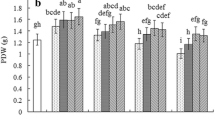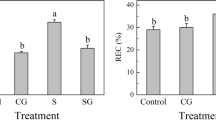Abstract
Nitraria tangutorum Bobr., a typical desert halophyte, plays an important ecological role because of its superior tolerance to severe drought and high salinity. Very little is known about the physiological adaptative mechanism of this species to environmental stresses. The aim of this study was to investigate the changes of antioxidant enzyme activities and the regulatory mechanism of ascorbate peroxidase (APX) activity in the calli from Nitraria tangutorum Bobr. after treatment with different NaCl concentrations. The activities of superoxide dismutase (SOD) and catalase (CAT) significantly increased in the calli treated with NaCl, while the peroxidase activity decreased. APX activity was also elevated significantly in response to NaCl, but the increase was partly abolished by H2O2 scavenger dimethylthiourea (DMTU). Furthermore, the excitatory effect of salinity on APX could be alleviated by the addition of exogenous CAT and nicotinamide adenine dinucleotide phosphate (NADPH) oxidase inhibitor diphenylene iodonium, indicating that the modulation of the APX activity in Nitraria tangutorum Bobr. calli might be associated with NADPH oxidase-dependent H2O2 generation. Measurement and analysis using fluorescent dye 2′,7′-dichlorodihydrofluorescein diacetate showed the increase of H2O2 content in salinity-treated calli. The investigation of NADPH-dependent O −2 production in plasma membrane (PM) vesicles isolated from Nitraria tangutorum Bobr. calli revealed that salinity treatment stimulated NADPH oxidase activity. In conclusion, these results suggest that the higher activities of antioxidant enzymes play an important role in the salt tolerance of Nitraria tangutorum Bobr. calli and that the extracellular production of H2O2, depending on the excitation of PM NADPH oxidase, is responsible for enhancing the APX activity in Nitraria tangutorum Bobr. calli under salinity stress.






Similar content being viewed by others
Abbreviations
- APX:
-
Ascorbate peroxidase
- ASA:
-
Ascorbate
- CAT:
-
Catalase
- DMTU:
-
Dimethylthiourea
- DPI:
-
Diphenylene iodonium
- DTT:
-
1,4-dithiothreitol
- EDTA:
-
Ethylenediaminetetraacetic acid
- FW:
-
Fresh weight
- H2DCF-DA:
-
2′,7′-dichlorodihydrofluorescein diacetate
- H2O2 :
-
Hydrogen peroxide
- LSCM:
-
Laser scanning confocal microscope
- MS:
-
Murashige and Skoog
- NADPH:
-
Nicotinamide adenine dinucleotide phosphate
- NBT:
-
Nitroblue tetrazolium
- PBS:
-
Phosphate-buffered saline
- PM:
-
Plasma membrane
- PMSF:
-
Phenylmethanesulfonyl fluoride
- POD:
-
Peroxidase
- PVP:
-
Polyvinylpyrrolidone
- ROS:
-
Reactive oxygen species
- SOD:
-
Superoxide dismutase
- Tris:
-
Tris-(hydroxymethyl) amino methane
References
Aebi H (1974) Catalase. In: Bergmeyer HU (ed) In methods of enzymatic analysis. Academic Press, New York, pp 673–677
Amstad P, Moret R, Cerutti P (1994) Glutathione peroxidase compensates for the hypersensitivity of Cu,Zn-superoxide dismutase overproducers to oxidant stress. J Biol Chem 269:1606–1609
Auh CK, Murphy TM (1995) Plasma membrane redox enzyme is involved in the synthesis of O −2 and H2O2 by phytophthora elicitor-stimulated rose cells. Plant Physiol 107:1241–1247
Avsian-Kretchmer O, Gueta-Dahan Y, Lev-Yadun S, Gollop R, Ben-Hayyim G (2004) The salt-stress signal transduction pathway that activates the gpx1 promoter is mediated by intracellular H2O2, different from the pathway induced by extracellular H2O2. Plant Physiol 135:1685–1696
Bor M, Özdemir F, Türkan I (2003) The effect of salt stress on lipid peroxidation and antioxidants in leaves of sugar beet Beta vulgaris L. and wild beet Beta maritima L. Plant Sci 164:77–84
Boyer JS (1982) Plant productivity and environment. Science 218:443–448
Bradford MM (1976) A rapid and sensitive method for the quantitation of microgram quantities of protein utilizing the principle of protein-dye binding. Anal Biochem 72:248–254
Buckhout TJ, Bell PF, Luster DG, Chaney RL (1989) Iron-stress induced redox activity in tomato (Lycopersicum esculentum Mill.) is localized on the plasma membrane. Plant Physiol 90:151–156
Dhindsa RS, Matowe W (1981) Drought tolerance in two mosses: correlated with enzymatic defence against lipid peroxidation. J Exp Bot 32:79–91
Dracup M (1991) Increasing salt tolerance of plants through cell culture requires greater understanding of tolerance mechanisms. Aust J Plant Physiol 18:1–15
Grosicka-Maciąg E, Kurpios D, Czeczot H, Szumiło M, Skrzycki M, Suchocki P, Rahden-Staroń I (2008) Changes in antioxidant defense systems induced by thiram in V79 Chinese hamster fibroblasts. Tox in Vitro 22:28–35
Joo JH, Wang SY, Chen JG, Jones AM, Fedoroff NV (2005) Different signaling and cell death roles of heterotrimeric G protein alpha and beta subunits in the Arabidopsis oxidative stress response to ozone. Plant Cell 17:957–970
Karlsson A, Nixon JB, McPhail LC (2000) Phorbol myristate acetate induces neutrophil NADPH-oxidase activity by two separate signal transduction pathways: dependent or independent of phosphatidylinositol 3-kinase. J Leuk Biol 67:396–404
Koca H, Bor M, Özdemir F, Türkan I (2007) The effect of salt stress on lipid peroxidation, antioxidative enzymes and proline content of sesame cultivars. Environ Exp Bot 60:344–351
Ksouri R, Megdiche W, Falleh H, Trabelsi N, Boulaaba M, Smaoui A, Abdelly C (2008) Influence of biological, environmental and technical factors on phenolic content and antioxidant activities of Tunisian halophytes. Compt Rend Biol 331:865–873
Kwak JM, Mori IC, Pei ZM, Leonhardt N, Torres MA, Dangl JL, Bloom RE, Bodde S, Jones JDG, Schroeder JI (2003) NADPH oxidase AtrbohD and AtrbohF genes function in ROS-dependent ABA signaling in Arabidopsis. EMBO J 22:2623–2633
Li Y (2008) Kinetics of the antioxidant response to salinity in the halophyte Limonium bicolor. Plant Soil Environ 54:493–497
Meloni DA, Oliva MA, Martinez CA, Cambraia J (2003) Photosynthesis and activity of superoxide dismutase, peroxidase and glutathione reductase in cotton under salt stress. Environ Exp Bot 49:69–76
Mishra NP, Mishra RK, Singhal GS (1993) Changes in the activities of anti-oxidant enzymes during exposure of intact wheat leaves to strong visible light at different temperatures in the presence of protein synthesis inhibitors. Plant Physiol 102:903–910
Mittler R (2002) Oxidative stress, antioxidants and stress tolerance. Trends Plant Sci 7:405–410
Moradi F, Ismail AM (2007) Responses of photosynthesis, chlorophyll fluorescence and ROS-scavenging systems to salt stress during seedling and reproductive stages in rice. Ann Bot 99:1161–1173
Morita S, Kaminaka H, Masumura T, Tanaka K (1999) Induction of rice cytosolic ascorbate peroxidase mRNA by oxidative stress; the involvement of hydrogen peroxide in oxidative stress signalling. Plant Cell Physiol 40:417–422
Munns R, James RJ, Läuchli A (2006) Approaches to increasing the salt tolerance of wheat and other cereals. J Exp Bot 57:1025–1043
Nakano Y, Asada K (1981) Hydrogen peroxide is scavenged by ascorbate-specific peroxidase in spinach chloroplasts. Plant Cell Physiol 22:867–880
Pang CH, Zhang SJ, Gong ZZ, Wang BS (2005) NaCl treatment markedly enhances H2O2-scavenging system in leaves of halophyte Suaeda salsa. Physiol Plant 125:490–499
Pei ZM, Murata Y, Benning G, Thomine S, Klüsener B, Allen GJ, Grill E, Schroeder JI (2000) Calcium channels activated by hydrogen peroxide mediate abscisic acid signalling in guard cells. Nature 406:731–734
Qin WM, Lan WZ, Yang XI (2004) Involvement of NADPH oxidase in hydrogen peroxide accumulation by Aspergillus niger elicitor-induced Taxus chinensis cell cultures. J Plant Physiol 161:355–361
Radyukina NL, Kartashov AV, Ivanov YV, Shevyakova NI, Kuznetsov VV (2007) Functioning of defense systems in halophytes and glycophytes under progressing salinity. Rus J Plant Physiol 54:806–815
Rao MV, Paliyath C, Ormrod DP (1996) Ultraviolet-B- and ozone-induced biochemical changes in antioxidant enzymes of Arabidopsis thaliana. Plant Physiol 110:125–136
Sagi M, Fluhr R (2001) Superoxide production by plant homologues of the gp91phox NADPH oxidase. Modulation of activity by calcium and by tobacco mosaic virus infection. Plant Physiol 126:1281–1290
Sekmen AH, Türkan I, Takio S (2007) Differential responses of antioxidative enzymes and lipid peroxidation to salt stress in salt-tolerant Plantago maritima and salt-sensitive Plantago media. Physiol Plant 131:399–411
Sergiev I, Alexieva V, Karanov E (1997) Effect of spermine, atrazine and combination between them on some endogenous protective systems and stress markers in plants. Compt Rend Acad Bulg Sci 51:121–124
Shalata A, Tal M (1998) The effect of salt stress on lipid peroxidation and antioxidants in the leaf of the cultivated tomato and its wild salt-tolerant relative Lycopersicon pennellii. Physiol Plant 104:169–174
Suo YR, Wang HL, Wang HQ (2004) Research on decreasing blood lipid and anti-oxidative effect of fruit of Nitraria tangutorum Bobr. from Qaidam Basin. Nat Prod Res Dev 16:54–58
Van Gestelen P, Asard H, Caubergs RJ (1997) Solubilization and separation of a plant plasma membrane NADPH-O −2 synthase from other NAD(P)H oxidoreductases. Plant Physiol 115:543–550
Wang CQ, Xu C, Wei JG, Wang HB, Wang SH (2008) Enhanced tonoplast H+-ATPase activity and superoxide dismutase activity in the halophyte Suaeda salsa containing high level of betacyanin. J Plant Growth Regul 27:58–67
Yahubyan G, Gozmanova M, Denev I, Toneva V, Minkov I (2009) Prompt response of superoxide dismutase and peroxidase to dehydration and rehydration of the resurrection plant Haberlea rhodopensis. Plant Growth Regul 57:49–56
Yang SM, Furukawa I (2006) Anatomical adaptations of three species of Chinese xerophytes (Zygophyllaceae). J For Res 17:247–251
Yang YL, Xu SJ, An LZ, Chen NL (2007) NADPH oxidase-dependent hydrogen peroxide production, induced by salinity stress, may be involved in the regulation of total calcium in roots of wheat. J Plant Physiol 164:1429–1435
Zhu Z, Wei G, Li J, Qian Q, Yu J (2004) Silicon alleviates salt stress and increases antioxidant enzymes activity in leaves of salt-stressed cucumber (Cucumis sativus L.). Plant Sci 167:527–533
Acknowledgements
This work is financially supported by the National Natural Science Foundation of China (grant no. 30960064) and the National Science Foundation for Distinguished Young Scholars of China (grant no. 30625008).
Author information
Authors and Affiliations
Corresponding author
Rights and permissions
About this article
Cite this article
Yang, Y., Shi, R., Wei, X. et al. Effect of salinity on antioxidant enzymes in calli of the halophyte Nitraria tangutorum Bobr.. Plant Cell Tiss Organ Cult 102, 387–395 (2010). https://doi.org/10.1007/s11240-010-9745-1
Received:
Accepted:
Published:
Issue Date:
DOI: https://doi.org/10.1007/s11240-010-9745-1




